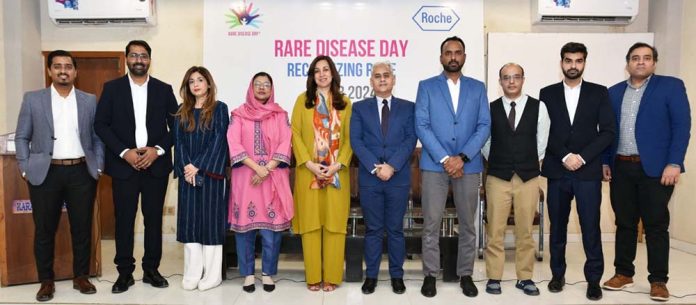In Pakistan, Rare Diseases Are Not Uncommon

Roche Pakistan Limited hosted a press briefing and panel discussion in honor of Rare Disease Day to increase public awareness of rare diseases in Pakistan and to highlight the unmet needs of patients, particularly in regards to funding, government support, and awareness. The panel included Dr. Yasir Adnan, Head of Medical at Roche, Ms. Hafsa Shamsie, MD Roche Pakistan, Dr. Raman Kumar, a pediatric neurologist, Dr. Munira Borhany, a hematologist, and Dr. Saqib Ali Shaikh, Director of Health Services, Government of Sindh.
Ms. Hafsa Shamsie, MD Roche brought attention to the fact that the cost of treating rare diseases is made much more challenging for people who have already received a diagnosis because of the absence of government funding and support for healthcare. Patients with rare diseases are the underserved exceptions in Pakistan’s healthcare system. Roche is a corporation dedicated to providing patients with rare diseases with cutting-edge medications that can enable them to have completely normal lives or at the very least, a significantly higher quality of life. She said that since 2017, Roche has operated a Patient Support Program that has provided nearly 25,000 patients with free therapy for a variety of illnesses, such as multiple sclerosis and spinal muscular atrophy. But no one organization or firm can handle the disease’s burden on its own as it increases. Because of this, enlisting the support of the government through public-private partnerships is essential, and it’s past time that “Recognizing Rare” also ranks highly among healthcare priorities.
The government is firmly committed to bolstering the current healthcare system, but it also acknowledges the hidden cost of rare diseases in the region, according to Dr. Saqib Ali Shaikh, Director of Health Services, Karachi, Health Department, Government of Sindh. He gave the audience an update on the government’s response to the rising number of hemophilia cases in Sindh. In spite of financial limitations, he took on the financial responsibility for some hemophilia patients’ ongoing treatment through the Sindh Hemophilia Society and expressed his desire to help more patients in the future.
He emphasized the importance of the Registry of Rare Diseases for the entire nation, not only Sindh. To help decision makers create future policies based on evidence-based data gathered from both the public and private sectors, he proposed including data on a few of the rare diseases that have been chosen based on their prevalence in the recently launched DHIS-2 (District Health Information System). According to him, public-private partnerships—such as the ones the government had started and was determined to pursue for the benefit of patients with rare diseases—hold the key to solving the issue of rare diseases.
Approximately 300 million people worldwide suffer from a rare condition, according to Dr. Yasir Adnan. Furthermore, Pakistan has a population of over 240 million, which makes the frequency of rare diseases in this nation more severe. Rare illnesses including hemophilia, multiple sclerosis, and spinal muscular atrophy not only present serious health and physical difficulties for the affected individual but also their family and the general public. Less than 10% of people with uncommon disorders receive treatment globally, according to him. Thus, the number of people with rare diseases who enter the system is already underrepresented, particularly in a nation with high rates of poverty and low literacy.
Spinal muscular atrophy (SMA) is a severe neuromuscular illness and one of the main hereditary causes of newborn mortality, according to Dr. Raman Kumar. Dr. Kumar recommended that the government and policymakers support patients with rare diseases and strengthen the healthcare system’s capacity to treat patients with uncommon diseases. In addition, he urged all pertinent parties to support individuals with SMA in gaining fair access to social opportunities, treatment, and diagnosis.
Hemophilia A, according to Dr. Munira Borhany, is a crippling and potentially fatal bleeding illness. Patients with hemophilia A may experience spontaneous bleeding as well as bleeding from injuries to the muscles, joints, and other internal organs, which has a significant negative impact on their quality of life. These hemorrhaging events have the potential to be deadly or cause irreversible joint impairment. Patients with hemophilia A also endure long-term psychological effects. Children encounter obstacles to socialization (missing school, unable to play with peers), which affects their choices for school and careers. According to her, our province governments must offer the greatest assistance possible, particularly with regard to standard-of-care therapy, in order for patients to lead normal lives and participate fully in society.

I am a dedicated student currently in my seventh semester, pursuing a degree in International Relations. Alongside my academic pursuits, I am actively engaged in the professional field as a content writer at the Rangeinn website.








